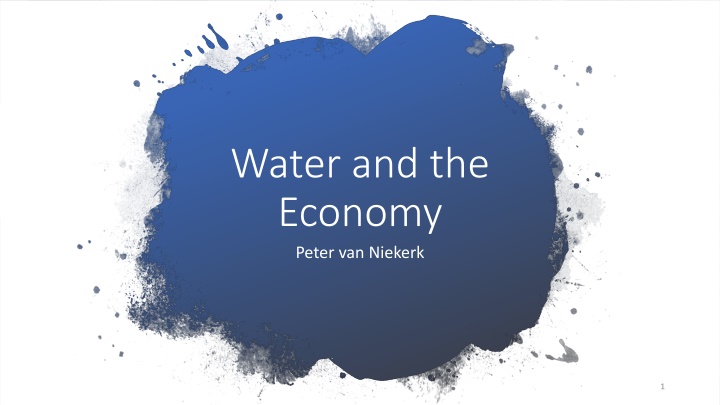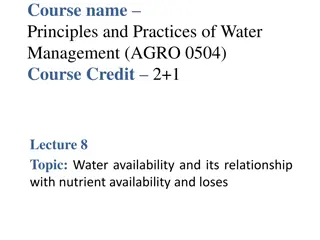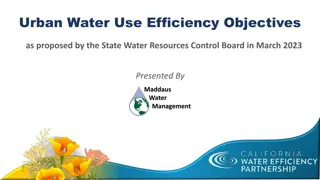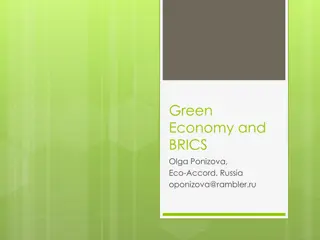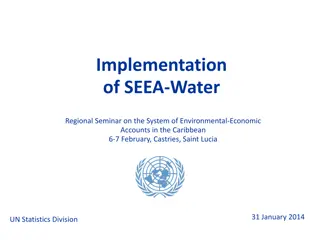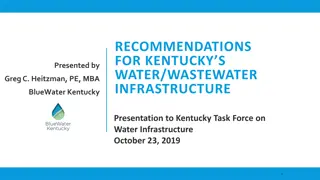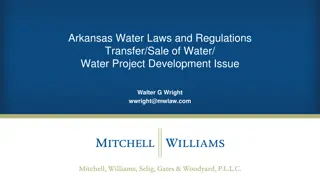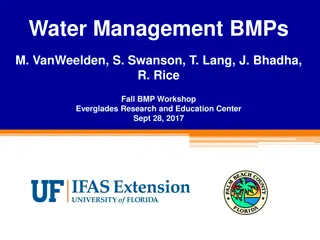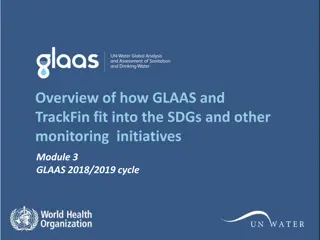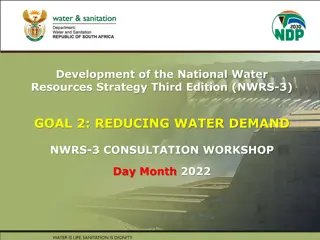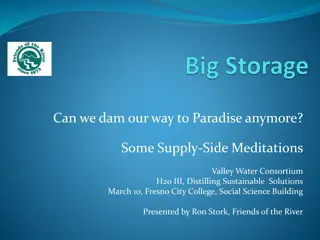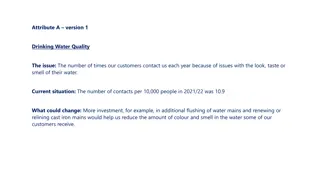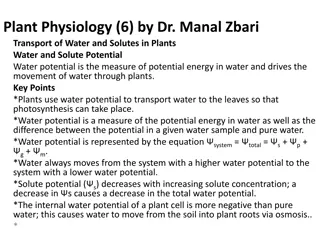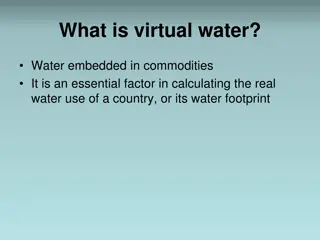Water and the Economy - Concepts and Analysis
This course delves into the economic aspects of water management, covering topics such as microeconomics, discounting, public vs private goods, project appraisal, and more. Explore the fundamental principles and terminology essential for evaluating water-related projects effectively.
Download Presentation

Please find below an Image/Link to download the presentation.
The content on the website is provided AS IS for your information and personal use only. It may not be sold, licensed, or shared on other websites without obtaining consent from the author.If you encounter any issues during the download, it is possible that the publisher has removed the file from their server.
You are allowed to download the files provided on this website for personal or commercial use, subject to the condition that they are used lawfully. All files are the property of their respective owners.
The content on the website is provided AS IS for your information and personal use only. It may not be sold, licensed, or shared on other websites without obtaining consent from the author.
E N D
Presentation Transcript
Water and the Economy Peter van Niekerk 1
Background Water Economics examines questions as wide as: 1. Is a public works project worth undertaking? From whose perspective? How should it be analysed? 2. How should water be priced? Should water rights be traded? 3. What levels of assurance of water supply are optimal? What are the impacts of under-supply during droughts? 4. Should South Arica use its water for water intensive production or rather import such goods? 5. Is water supply better left for the State, or should the private sector do it? In this course we will concentrate on the first question rooted in welfare economics, a segment of micro-economics. We start first with concepts and terminology. (Yes the field has its own language!) 2
We will cover the following: Concepts Microeconomics vs Macroeconomics Discounting Supply and demand Cost and Return Marginal cost and Marginal Revenue Price elasticity of demand Public, Private and Economic Goods Project Appraisal Benefits Costs Opportunity costs Internal rate of return Least Cost Analysis Benefit Cost Analysis Cost Efficiency Analysis (URV) 3
Microeconomics vs Macroeconomics Microeconomics Price determination Allocation of scarce resources among competing uses Welfare economics provides theoretical foundation to evaluate public works projects (also called public engineering projects) Macroeconomics Analysis of broad aggregates such as GDP, total employment, inflation 4
Discounting: Present Value Consider a simple investment of USD 3000 that makes an annual payment of USD250 for 5 years, if the discount rate is 7% What are the cash flows? What are they worth today: Present Value? 5
Economic discounting: What rate? Discount rate reflects time value of money Discount rate for an economic analysis differs from interest rate (financial market) extensive literature exists on appropriate discount rate for public works projects. Official discount rate (social discount rate) in South Africa is 8% p.a. Note that: Lower discount rates favour capital intensive projects Lower discount rates favour projects with long gestation periods A low discount rate requires a longer planning horizon Typically, for water resource projects, a planning horizon of 45 years is used and sensitivity analyses round the 8% discount rate, at 6% and 10%, are undertaken. 6
Perspective on Demand (Consumers) and Supply (Firms) Economists starting points: Perfect economy: no economic distortions, free entry into market, no monopolies, no transaction costs, no taxes, perfect information, producers and consumers are price takers A consumer will allocate her fixed budget in such as way to optimize her utility Benefit for consumer diminishes with increasing supply If the price of the commodity in the graph is set at 2 the consumer will buy 38, not more If the price increases the consumer will buy less 7
Adding supply of commodity q Producers will increase supply as price increases (in a prefect economy) At price p the market clears it is in equilibrium
Production Costs FC = Fixed costs VC = Variable costs TC = Total Costs
Competitive market Average Total Cost (ATC) , Average Variable Cost (AVC) and Marginal Cost (MC) If price is above ATC curve, excess profit is made and other firms will enter market Markets will clear and allocative efficiency occurs when consumers pay a market price that reflects the marginal cost of production. The condition for allocative efficiency for a firm is to produce an output where marginal cost, MC, just equals price, P2. The quantity produced will be Q2 Marginal Revenue (MR) is therefore = price P2 Note that this is when the ATC curve is at its minimum
Monopolies Case where there is a single seller and many buyers To maximize profit the firm will produce at the point where MC=MR The quantity produced will be at point B, less than the minimum point of the ATC curve if it were perfect competition. The monopoly will make above- normal profit Public work activities are usually natural monopolies as the barriers of entry for competitors are too high.
Price elasticity of demand 12
Price elasticity of demand 13
Public Good vs Private Good A public good has two characteristics: Non-rivalry: When a good is consumed, it doesn t reduce the amount available for others. E.g. benefiting from a street light doesn t reduce the light available for others but eating an apple would. Non-excludability: It is not possible to provide a good without it being possible for others to enjoy. For example, if you build a dam to stop flooding you protect everyone below the dam, whether they contributed to the dam or not. The availability of a private good can be exhausted through use. It is difficult to assess benefit/value of a public good during the planning process problem of overstatement of willingness-to-pay by public. Afterwards free rider issues. 14
Private or Public good? Discuss whether the following are private or public goods A beach A museum TV broadcasts Electricity A park Water reticulated to a house Water in a river Also note positive and negative externalities often associated with public goods. 15
Indifference Curves Water is different to normal goods. - both a private, marketable good and a basic human right.
Demand forecasting A planner needs to estimate future water requirements. Various forecasting techniques can be used, including Regression techniques Econometric modelling Time series forecasting This module does not include further detail it is incorporated in the Options Analysis module 17
Identification of Options After forecasting demands into the future the Planner has to identify options to reconcile demands with supplies of water. (This aspect is covered elsewhere in the course.) For this module it is assumed viable options have been identified and are ready for economic analysis. 18
Reconciling demand and supply by adding a new resource According to projections a new resource intervention, say a dam, is required at T1 as risk of under supply becomes too great The dam increases system yield from Y1 to Y2 Supply meets minimum levels-of service until T2, by which time the next intervention is required The dam assures additional system yield into future as shown in shaded area 19
Identification and Quantification of Benefits Direct monetary benefits Also seen as increase in national income (GDP as proxy for welfare ) Assumes price reflects societal value High degree of competition High degree of employment of labour and productive capacity Absence of external economic forces, diseconomies, taxes Otherwise shadow pricing required to correct for distortions Indirect benefits: Example: A proposed new irrigation project will have indirect or secondary benefits: Project will result in increase in income in processing, transporting and marketing of products grown with the project water and increase labour in those sectors( forward linkages ) Expenditure on the project (on factors of production) will increase income earned by firms involved in supplying inputs for the projects and increase labour in those sectors( backward linkages ) Secondary benefits are not included up front in cost-benefit analyses, but Secondary benefits can be explicitly computed in Leontief input-output models to trace effects of investments in one economic sector on another, or on labour, e.g. employment capital multiplier (jobs per million rand invested). 20
Identification and Quantification of Costs Cost estimations (such as engineering costs) are dealt with elsewhere and assumed available for our purposes Direct Costs Capital cost Operating cost Maintenance cost Past expenditure are treated as sunk costs and therefore has no relevance Transfer Payments Such payments do not reduce resources in economy as a whole Taxes, duties and subsidies are examples of transfer payments Shadow Pricing required where pricing is distorted, e.g. electricity costs Opportunity Costs Benefit foregone from not using a good or resource in its next best alternative use, e.g. land required for a new dam Depreciation of capital assets over the planning horizon to be included as a cost by bringing in new assets at appropriate times. 21
Economic theory applied in water resource appraisal: Least cost analysis Cost-benefit analysis (CBA) Cost-effectiveness analysis (CEA). We will briefly look at these methods, but further reading is recommended: WRC Technical Report No. TT 177/02 22
Least cost analysis Choose between projects with very similar objectives E.g. water supply to a village for the next ten years growth and choosing between ground water abstraction and a dam Select project with lowest Net Present Cost (NPC) 23
Cost-benefit analysis (CBA) Through CBA the desirability of a public investment project is assessed Started in 1930s in USA to assess benefits to society of various water resource related legislation Applied where it is possible to quantify costs and benefits in monetary terms Example of benefits: net farm income (for an irrigation scheme) or value of electricity generated (hydroelectricity power scheme) Generally market prices are used, but sometimes shadow prices are required to adjust for market failures and effects of government intervention Secondary benefits are not included 24
Cost-benefit analysis (CBA) (contd) Benefit-cost Ratio PV of total benefits divided by PV of total costs B/C ratio must exceed 1 for a project to be economically justified Internal Rate of Return (IRR) IRR = Discount rate at which the present value of the net cash flow is zero The higher the IRR the better is a project 25
Cost-effectiveness analysis (CEA) Non-monetary metric (e.g. when difficulty of placing monetary value on benefits) If the effectiveness measure captures most of the benefits, then it may be reasonable to use CEA to avoid the burden of conducting a CBA Cost-effectiveness ratio, e.g. for a road project, R million invested, divided by lives saved per year, compares (mutually exclusive) alternatives in terms of the ratio of their costs and a single quantified, but monetized, effectiveness measure As it is difficult to put monetary values on supplying water for urban and industrial purposes, CEA is often used called the Unit Reference Value method in South Africa. 26
Unit Reference Value (URV) Unit Reference Value (URV) URV measure originated with DWA in South Africa in the 1980s Today used extensively to compare and rank water projects Referring to figure: The total quantity of water supplied is shown in the shaded area, i.e. the sum of all annual demands starting at time T1, growing till equalling the yield of Y at time T2, and thereafter remaining constant until the end of the economic life of the scheme (typically 45 years). The URV of the scheme is derived by dividing the PV of the costs with the PV of the water supplied, as in this equation: ????????? URV = ??????????????????????????? 27
Unit Reference Value (URV) (contd) Unit Reference Value (URV) (cont d) From a CEA perspective effectiveness is considered captured by the PV of quantity of water supplied . This is valid in most cases but may need adaptation in cases involving variable operating costs, such as certain inter-basin transfers. NOTE: URV comparisons should be limited to projects within same effectiveness domain e.g. should not be used to compare a supply side project, such as a dam which increases system yield, with a demand side project, such as one directed at reducing reticulation leakages. 28
END 29
Economic Goods An economic good is a good or service that has a benefit (utility) to society. Also, economic goods have a degree of scarcity and therefore an opportunity cost. This is in contrast to a Public Good (like air, sea water) where there is no opportunity cost but abundance. With economic goods have some scarcity and value, people will be willing to pay for them (in some form). Another feature of an economic good is that if it can have a value placed on the good, it can be traded in the marketplace and valued, using a form of money. 30
